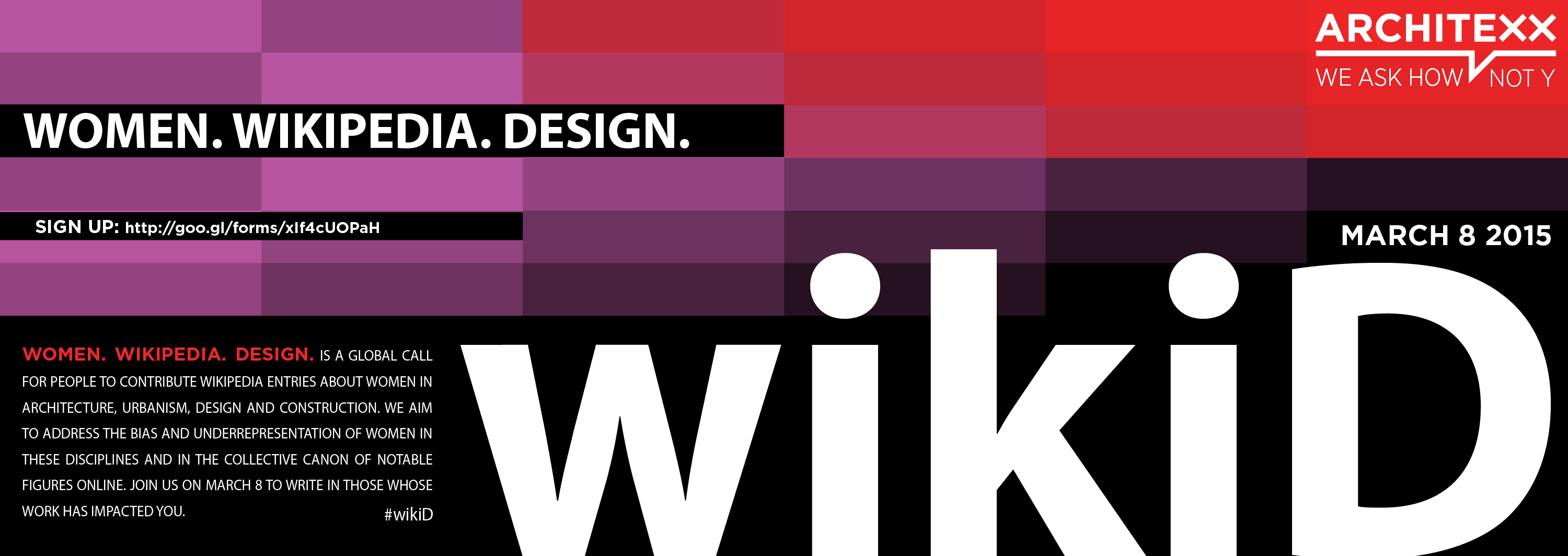by Sarah Rafson and Lori Brown
In her essay for Places, “Unforgetting Women Architects: From the Pritzker to Wikipedia,” Despina Stratigakos discusses the lack of women architects in our history books, current publications, and in our public consciousness. Unfortunately, some of those who are written into the historical record on Wikipedia are just as quickly being edited out. ArchiteXX felt that we had to take action. Global action. We organized the first-ever international #wikiD event on International Women’s Day, 03.08.15, to write more women architects, designers, and all those involved in the creation of our built environment, into Wikipedia. ArchiteXX teamed up with the Beverly Willis Architecture Foundation and the AIA New York Chapter for a #wikiD party at the Center for Architecture in New York; it took place concurrently with editing parties internationally on the same day. All told, the #wikiD campaign was a needed shot in the arm that brought widespread awareness to the issue, but now we’re tasked with leveraging that momentum to solve the Wikipedia gender gap in the long run.
Over the past several years there has been a lot of discussion, both in the media and in academic circles, about women not being included in Wikipedia in parity with their male counterparts. Science, engineering, art, architecture, and literature are just a few fields where prominent women either lack a Wikipedia entry or have an entry at risk of deletion. Combined, the low number of women entries – and the low number of women who regularly edit Wikipedia – means that there is a significant gender gap on this important platform. The problem is only confounded by some shockingly successful efforts to edit women out, either by claiming redundancy and combining their entries with a partner’s, or questioning their notoriety. As a popular and regular go-to quick reference resource for the general public, it stands to reason that writing more women involved in constructing our world into Wikipedia will increase awareness of the expanding role women play in shaping our world. That is the goal – but it takes some maintenance and perseverance.
The #wikiD campaign received support near and far, with people writing from Australia, Spain, Portugal, England, Ireland, Germany, Norway, Romania, various cities in the United States, and Canada. Not too bad for our first year! One thing we discovered was how empowering the act of writing is. By writing someone into Wikipedia, you are helping create a new history – one that is far more representative of those who are actually engaged in building, thinking, and teaching about the design of space.
This year, we worked from many resource lists, such as those from the Beverly Willis Architecture Foundation and the International Archive of Women Architects, and it is clear that there are still many women who still need to be written in, and many more entries that need to be strengthened.
Next year, we seek even greater global engagement by working with students of architecture and design programs across the globe. We can imagine no better way to expand the breadth and depth of architectural knowledge – in both a historical and contemporary sense – than to engage those who are asking to learn about more women in their architecture history, theory, and design courses. When students participate in changing the history and representation of architecture and design, they are helping us alter the future of the discipline.
Join us next year!
Lori Brown is co-founder and co-leader of ArchiteXX, an associate professor of architecture at Syracuse University, and a licensed architect in New York State.
Sarah Rafson is an architecture writer and researcher based in New York, and a co-editor of SubteXXt, an online journal about women in architecture affiliated with ArchiteXX.
Event: women. wikipedia. design. #wikid
Location: Center for Architecture, 03.08.15
Organizers: Architexx
